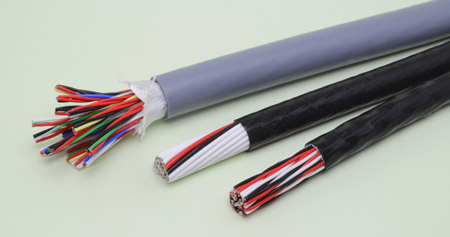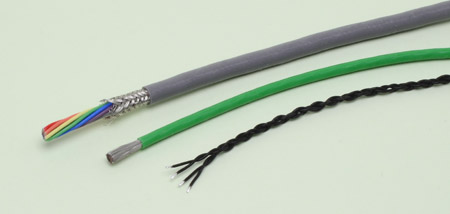Heat-resistant Insulated Wire
Having started with glass insulated heat-resistant wire (GB product) that uses glass yarn as the insulating material, the most common heat-resistance insulating material, Ninomiya Electric Wire now provides heat-resistant wires based on a variety of heat-resistant insulating materials such as silicone rubber, fluorine resins, polyimide, mica, and silica-glass, which are well accepted in many areas. The recent significant improvements in science and technology have created diversified requirements for heat-resistant insulated wire, such as use at unprecedentedly ultrahigh temperatures; chemical resistance; excellent insulating performance; resistance to weather, aging, and radiation; high mechanical strength; and flexibility. Through persistent effort and development and research activities, we are aggressively responding to these requirements as a vendor specializing in heat-resistant wire by, for example, using ceramic fibers as new insulating materials. In addition to these wires, we are gradually expanding the product lineup of UL-approved heat-resistant wires.
Product Search
Supplementary Information
Frequently Asked Question (FAQ)
Frequently asked questions and answers about heat-resistant wires can be found here.
- Regarding allowable current
- Regarding products that aren't listed in the catalog
- Regarding the minimum bending radius of the product and the maximum obtainable length
- Does it comply with the RoHS2 Directive?
- Regarding service life of electric wires/cables
- Regarding appearance (streak-like discoloration) of silica glass braided products
- Technical questions and questions about product selections
- Q.Regarding allowable currentA.The allowable current is the maximum current that can be passed through the wire at all times. The allowable current value is determined by the type of wire, conductor size, ambient temperature, laying method, etc.
The allowable current values when used in an open normal atmosphere are listed in the "Allowable Current Table" (P.4 - P.9) in this catalog. When the product is to be stored in a conduit or used in multiple centers, apply the value multiplied by the current reduction coefficient shown at the bottom of the allowable current table.
Additionally, please be aware that the wire can become hot due to self-heating even if the current used is within the allowable current value. Upon usage, please take extra safety precautions. -
Q.Regarding products that aren't listed in the catalogA.The products listed in the catalog are typical products. We are proactively accepting requests for custom products to meet a wide range of customer needs. Please feel free to contact us. Below shows photographs of custom-designed multi-core cables and a wire structured with the fine-wire conductor.

Custom-designed multi-core cables

Custom-designed multi-core cables, a wire structured with the fine-wire conductor -
Q.Regarding the minimum bending radius of the product and the maximum possible lengthA.Please let us know the product you are considering. We'll answer your questions.
-
Q.Does it comply with the RoHS2 Directive?A.None of the products listed in this catalog contains any of the 10 restricted substances specified by the RoHS Directive (2011/65 / EU) and the European Commission Delegation Directive ((EU) 2015/863) that exceeds its threshold, and they all comply with these directives. We can also issue a RoHS Directive Conformity Certificate, so please inform us of the product concerned.
-
Q.Regarding service life of electric wires/cablesA.We don't set guidelines for the service life of our heat-resistant electric wires because it's expected that they will be used in various situations in special environments. The service life of electric wires and cables varies largely depending on the laying environment and service conditions. The possible main deterioration factors that can shorten the service life include electrical factors (overvoltage, overcurrent, etc.), mechanical factors (bending, vibrations, twisting, tension, etc.), thermal factors (deterioration of the physical properties due to high and low temperatures), and chemical factors (chemicals, oil, gases, etc.). The combination of these factors can also cause deterioration.
-
Q. Regarding appearance (streak-like discoloration) of silica glass braided productsA.Depending on the production lot of the above products, "blackish streak-like discoloration" may be seen on the external silica glass. (This is different from the product specifications that contain streaks.) This discoloration occurs when the paint applied to the product exterior by baking. Please rest assured that this won't cause any problems to product performance. If you have any questions about this matter, please contact our sales department.
-
Q.Technical questions and questions about product selectionsA.If you have any technical issues or questions regarding product selection, please feel free to contact us via email or phone. (TEL.042-753 – 4151) (FAX.042-753-4460)(http://www.ninomiya-ew.co.jp/en/) ( mail: info@ninomiya-ew.co.jp)

